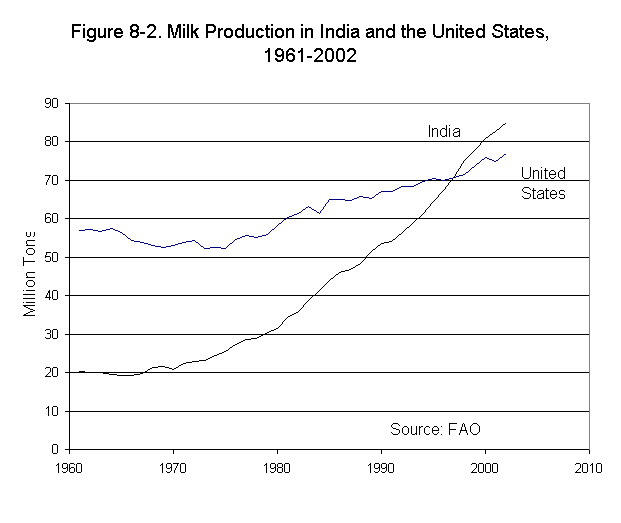Lester R. Brown
Chapter 8. Raising Land Productivity: A Second Harvest
Another initiative that can have the effect of raising land productivity involves ruminants, such as cattle, sheep, and goats. Although rangelands are being grazed to capacity and beyond, there is a large unrealized potential for feeding agricultural residues—rice straw, wheat straw, and corn stalks—to ruminants, which have a complex digestive system that enables them to convert roughage, which humans cannot digest, into animal protein. This means that a given grain crop can yield a second harvest—the meat or the milk that is produced with straw and corn stalks.
India has been uniquely successful in using cattle and water buffalo to convert crop residues into milk, expanding production from 20 million tons in 1961 to 85 million tons in 2002—a more than fourfold increase. Following a path of steady growth, milk became India's most valuable farm product in 1994, eclipsing rice. In 1997, India overtook the United States to become the world's leading milk producer. (See Figure 8-2.) Remarkably, it did so almost entirely by using farm byproducts and crop residues, avoiding the diversion of grain from human consumption to cattle.28
Between 1961 and 2002, India's milk production per person increased from 0.9 liters per week to 1.6 liters, or roughly a cup of milk per day. Although this is not a great deal by western standards, it is a welcome expansion in a protein-hungry country.29
India's milk is produced almost entirely by small farmers with one to three cows. Milk production is integrated with crop production, involving an estimated 70 million farmers for whom it is a highly valued source of supplemental income. Ownership of a few cows also means a supply of manure for fertilizer.30
In China, where double cropping of winter wheat and corn is common, wheat straw and corn stalks are removed from the land because there is not enough time for them to decompose before the next crop is planted. As the world's leading producer of both rice and wheat and the second largest producer of corn, China annually harvests an estimated 500 million tons of straw, corn stalks, and other crop residues. At present, with much of this either burned, simply to dispose of it, or used as fuel for cooking, there is a large potential for China to follow India's lead in using crop residues to raise protein productivity.31
The ammoniation of crop residues (the incorporation of nitrogen) in the roughage helps microbial flora in the rumen of the cattle and sheep to digest the roughage more completely. The use of this technology in the major crop-producing provinces of east central China—Hebei, Shandong, Henan, and Anhui—has already created a "Beef Belt." Beef output in these four provinces now dwarfs that of the grazing provinces of Inner Mongolia, Qinghai, and Xinjiang.32
The achievements of China in aquaculture, of India in expanding its milk production, and of other countries in producing protein more efficiently hold out hope for being able to satisfy the growing world demand for protein without clearing additional land for agriculture, assuming that we can stabilize population soon.

*Data and additional resources have been omitted from this mobile version of our website to ensure the most optimal experience. To view this page with its entire information, please visit the full website.